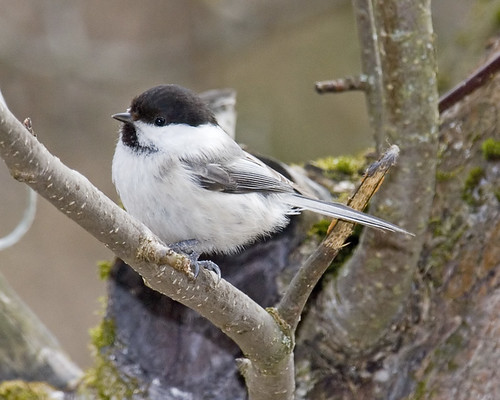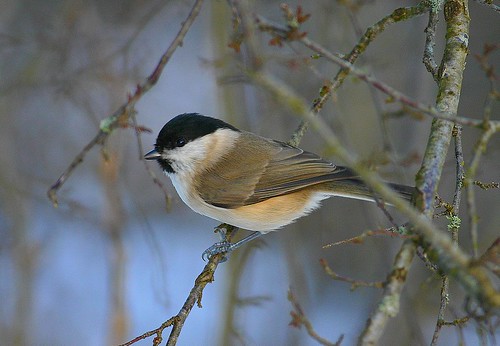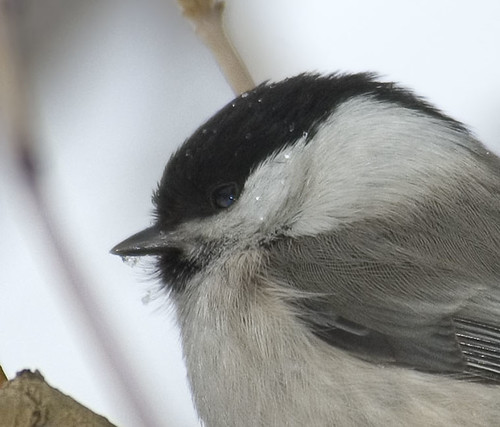Both the Willow Tit (Weidenmeise) and the Marsh Tit (Sumpfmeise) are fairly common here in Tirol, but I don't think I have ever seen them together, or even near each other.
The Willow Tit is most commonly found up near the edge of the tree line, and in the forest edge habitat alongside the high, mountain pastures (think Heidi and Peter playing in the fields). The easiest way to find them while birding is to just keep a look out for any little birds moving about (there are bound to be few, you are birding in the high Alps after all ;-), and keep your ears open for their call (play here from www.garden-birds.co.uk). The rasping sound carries fairly well in the forest and open habitats.
The Willow Tit is most commonly found up near the edge of the tree line, and in the forest edge habitat alongside the high, mountain pastures (think Heidi and Peter playing in the fields). The easiest way to find them while birding is to just keep a look out for any little birds moving about (there are bound to be few, you are birding in the high Alps after all ;-), and keep your ears open for their call (play here from www.garden-birds.co.uk). The rasping sound carries fairly well in the forest and open habitats.

Willow Tit showing pale wing windows, large black bib, white ears, and bull neck; originally uploaded by Sergey Yeliseev.
As with most birds up in the Alps, you can be walking/birding for hours in the right habitat and not find anything and then suddenly, a flock flies up and lands in the tree right in front of you. Besides active searching in the high mountains, don't forget to check the gardens and bird feeders of houses or settlements in the mountains. Last weekend we saw quite a few Willow Tits hanging out and feeding in the garden of a small Alpine hamlet (see Juifenau location / sighting). Despite what my Collins Bird Guide says, Willow Tits do feed at winter feeding tables, at least here in the Alps.
Having said that, if you see tits feeding at a winter feeding table, it is way more likely to be a marsh tit than a willow tit. Marsh Tits are fairly common in the gardens and riparian woodland of Innsbruck and the surrounding villages, particularly those along the River Inn, and I often come across Marsh Tits while birding in my local patch (the Inzinger Gaisau). The marsh tits tend to be in lower lying areas, often somewhat near water and seem to really love broad-leaved riparian woodland. Keep an ear open for the marsh tit call (play here from www.garden-birds.co.uk). For tits, they can be a little more weary than some of the other tit species, but I would certainly not call them shy.

Marsh tit, showing brown (not pale) wing windows, smaller bib, buff ears, and a hint of white at the base of the bill; originally uploaded by giuss95.
The best way to tell a marsh tit from a willow tit is by call (try listening to the calls above a few times). If, like me, you suck at remembering a million birds' million different calls and songs, then you may have to rely on some more creative methods.
The first involves putting the calls on your mobile phone, mp3 player or pda so that you always have samples of the calls with you when you need to tell them apart.
If that is not an option or you are feeling visually inclined, then here are a few physical features you can use:
- the willow tit is characteristically bull-necked. Because it excavates its own breeding cavity (unlike the marsh tit), it has a much sturdier and thicker neck. This is not always that obvious and a marsh tit can look large necked as well, depending on its sitting position
- if you are able to get a good look at the bird, then look for a lighter/pale dot at the base of the bill. If so, then you are almost certainly looking at a marsh tit.
- the white cheeck patch of the willow tit appears to extend well back, all the way to the extension of the black hood on to the nape. in the marsh tit, the whiteness of the cheeks quickly changes to a light buff over the ears
- willow tits tend to have a pale margin to the secondary flight feathers, giving them a "pale window" effect on the folded wing (this can be lost with lots of feather wear). Marsh tits can have something similar, but generally to a much lesser extent, and only when the feathers are really fresh.
- The chin bib of willow tits tends to be larger with a greater scattering of dots than that of most marsh tits.

Willow Tit, showing extensive white cheek and ear patches, a fairly broad bib, and no white at the base of the bill; originally uploaded by Sergey Yeliseev.
With a little practise, identifying marsh and willow tits is not all that hard, but it always takes looking at a couple of features before deciding on an ID. For a more in-depth look at marsh and willow tit identification, refer to Brian Stretch's identification article (here).
Happy birding
Dale






.jpg)



.jpg)








.jpg)



7 comments:
Very educational. I most likely would have glanced at either of them and took them for chickadees since we don't have tits here. I really love the charming little birds. This time of year I'm trying to see a golden-crowned kinglet.
no, all of the images in the blog are, in fact, of chickadees. I believe it is called neo-collonialism. the chickadees are moving back over to the old countries to take over. they are disguised as tits to blend in. when there are enough of them they will put in to action their wicked plans
haaa haa haa
(wicked laugh)
Willow Tit has no physical adaptions for excavating a hole - it does not have a 'thicker' or 'sturdier' neck for that purpose. It has no more muscular neck than marsh tit. The reason why it can look more bull-necked is that the feathers are longer and more dense on willow tit (a boreal species in origin) than marsh tit (a more southerly species). But it is a very unreliable character.
well then, Anonymous, I suppose it must just be a [non]urban myth then, widely repeated wherever you look.
Thank you for your comment and insight.
D
It's impossible to discern anything about muscle just by looking at a bird, as they're covered in feathers. Just as you cannot tell a fat bird from a thin bird by eye. It was an assumption that got into print in the dark ages and has been repeated since. It makes very little sense when you think about it, seeing as Marsh Tits are also (partial-)excavators that habitually excavate. It's just that they never initiate cavities from scratch.
Ya, what you say makes complete sense. there really are a lot of cases where anecdotal evidence and speculation slowly work their way in to "common knowledge" without any real basis. One of my academic colleagues used to say, "hear something wayward once and it is a rumour, hear it twice and it becomes a theory, hear it a third time and it is fact"
But I do believe that the whole fat neck thing is a fairly decent guide (when used in combination with other indicators) to Marsh/Willow Tit ID, particularly when one has plenty of experience with both.
Oh, and do you have some good reference material on the Boreal/southern origin of the two species, I would love to read up a little more about it
great catch with the Willow Tit and Marsh Tit, it is really sharp and crisp. Love to see some much details posted on these beautiful birds.
Post a Comment